

WEEK 28: JULY 5-11
TOPIC: PAST SPACECRAFT MISSIONS
The majority of what we know about the various planets and many of the other objects in our solar system has come from spacecraft missions sent to those bodies. Even with the best telescopes here on Earth many of these objects are little more than points of light in the sky, and it was only when we began to make up-close observations with visiting spacecraft that we truly began to understand the other residents of our solar system as worlds in their own right. Even the first missions to the moon – the Luna 2 and 3 missions sent by the then-Soviet Union in 1959 – significantly increased our knowledge about Earth’s natural satellite, and the first successful interplanetary mission – NASA’s Mariner 2 mission to Venus in 1962 – substantially increased our knowledge of our nearest planetary neighbor, including the confirmation of Earth-based measurements that suggested Venus’ surface is very hot.
In a similar fashion, the twin Voyager 1 and 2 missions have examined some of the smaller moons of the outer planets. Voyager 1 discovered two small inner moons of Jupiter when it flew by that planet in 1979 and three moons of Saturn when it passed by that world in 1980; Voyager 2 found an additional small inner moon of Jupiter and then went on to discover eleven moons around Uranus in 1986 and five moons around Neptune in 1989. The Cassini spacecraft that orbited Saturn between 2004 and 2017 examined several of the Voyager-discovered moons in some detail also discovered eight additional moons. Along with Phobos and Deimos, these objects are also discussed in a future “Special Topics” presentation.
Beginning in the 1980s, several “small bodies” have been the primary or secondary destinations of several spacecraft missions
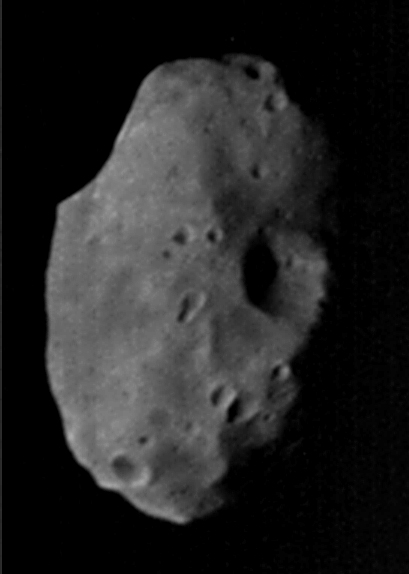
The return of Comet 1P/Halley in 1986 created widespread interest in sending spacecraft missions to that object, and several nations in fact did so. Conspicuous by its absence was the U.S., where Congress had failed to fund such a mission. In response to this disappointment felt by many American scientists, planetary scientist Robert Farquhar at NASA’s Goddard Space Flight Center in Maryland proposed an alternate idea: utilize an already-existing spacecraft, the International Sun-Earth Explorer 3 (ISEE-3), and send it to an encounter with Comet 21P/Giacobini-Zinner a few months before the various other spacecraft arrived at Comet Halley.
ISEE-3 had been launched on August 12, 1978, as part of an international three-spacecraft mission to study the interaction between the solar wind and the earth’s magnetosphere from the L1 Lagrangian point 1.6 million km sunward of Earth, and by the early 1980s had successfully completed its original planned mission. On June 10, 1982, ISEE-3 was moved from its position at L1 and, in a highly complex series of maneuvers which involved five flybys of the moon – the last one being only 120 km above the lunar surface on December 22, 1983 – was then placed in a flight path toward Giacobini-Zinner. At that time the spacecraft was re-christened the International Cometary Explorer (ICE).
ICE successfully encountered Comet Giacobini-Zinner – a future “Comet of the Week” – on September 11, 1985, passing through the comet’s ion tail 7700 km “downstream” from its nucleus, and becoming the first spacecraft to visit a comet. While ICE did not carry any cameras or imaging equipment, it did contain several scientific instruments which reported on the electrical environment around the comet and its interaction with the solar wind. Among other things, ICE reported that the comet’s magnetic field reversed polarity directly at the ion tail and detected a large proportion of ionized water molecules.
Following its encounter with Comet Giacobini-Zinner, ICE went on to a relatively distant encounter (0.19 AU) with Comet Halley in late March 1986 and then continued to carry out observations of solar phenomena and the interplanetary space environment until its mission was formally ended in 1997. In 2014 ICE returned to the Earth’s vicinity and a privately-funded recovery effort led by space entrepreneur Dennis Wingo successfully re-established contact with it and was able to command it to perform a firing of its thrusters. However, not enough propellant was left to allow ICE to be maneuvered into a location where a future recovery could be performed, and after a couple of months contact was lost.
The international armada of spacecraft that visited Comet Halley in March 1986 is discussed in some detail in that comet’s “Comet of the Week” presentation. The armada included two Japanese probes, Sakigake and Suisei, which studied the comet from a distance, and two probes from the Soviet Union, Vega 1 and 2, which, after passing by Venus in mid-1985 and deploying surface landers and atmospheric balloons, passed within a few thousand km of Halley’s nucleus and returned the first-ever direct images of a cometary nucleus. The highlight was ESA’s Giotto mission which passed 600 km from Halley’s nucleus on March 14, 1986 and returned relatively sharp images of the nucleus as well as many important scientific observations of the nucleus and the near-nucleus environment.
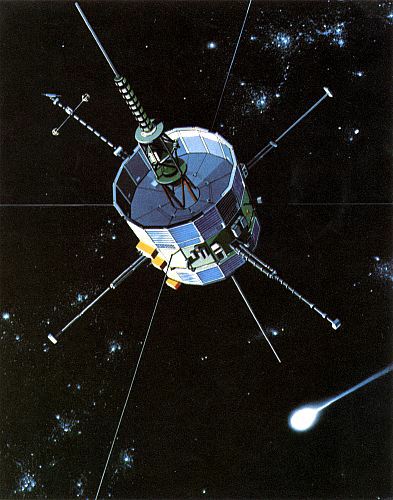
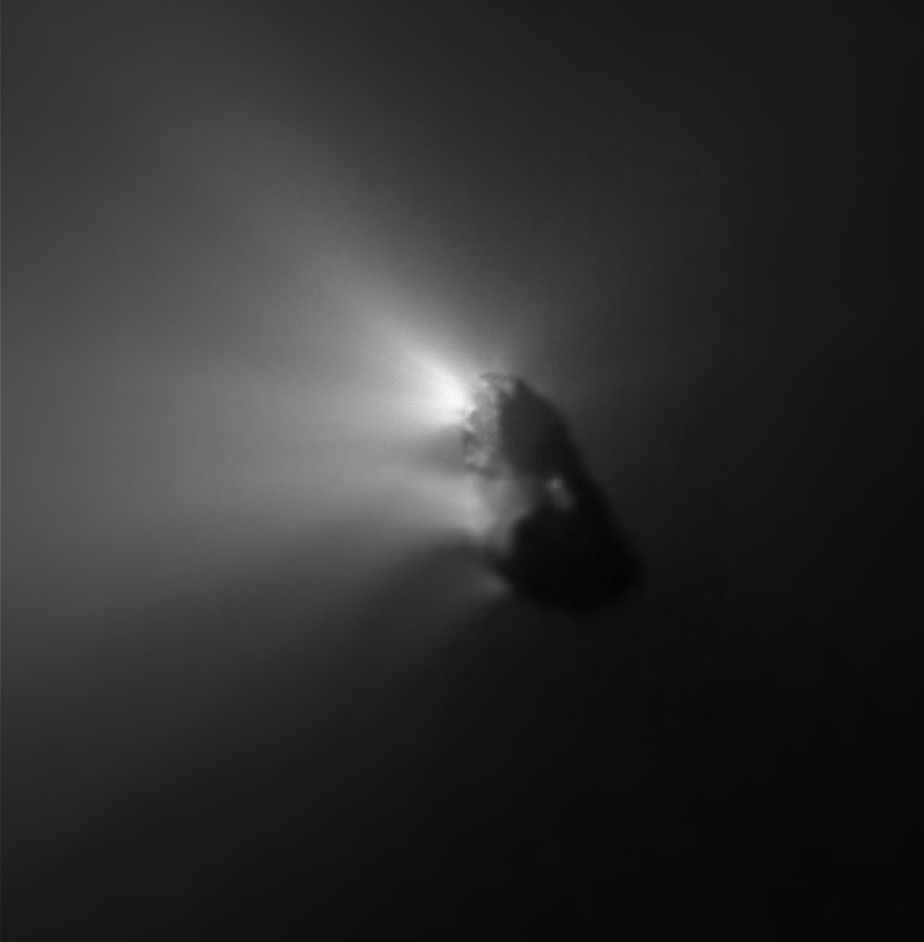 LEFT: Artist’s conception of the International Comet Explorer (ICE) encounter with Comet 21P/Giacobini-Zinner in September 1985. Courtesy NASA. RIGHT: The nucleus of Comet 1P/Halley, as imaged by ESA’s Giotto spacecraft on March 14, 1986. Courtesy ESA.
LEFT: Artist’s conception of the International Comet Explorer (ICE) encounter with Comet 21P/Giacobini-Zinner in September 1985. Courtesy NASA. RIGHT: The nucleus of Comet 1P/Halley, as imaged by ESA’s Giotto spacecraft on March 14, 1986. Courtesy ESA.
Giotto went on to another cometary encounter, with Comet 26P/Grigg-Skjellerup, passing 200 km from that object’s nucleus on July 10, 1992. Because of the “sand-blasting” that occurred when Giotto has passed through Halley’s inner coma – exacerbated by the comet’s retrograde orbital motion which in turn created very high relative velocities, and thus very high kinetic energies, for impacting dust particles – Giotto’s camera was no longer functional, but some of its other scientific instruments were still intact and were able to make some important measurements.
NASA’s Galileo mission to Jupiter was originally scheduled to be deployed from the Space Shuttle in late 1986, however the Challenger disaster earlier that year not only delayed the Galileo launch by three years but also forced a longer and more circuitous trajectory that included gravity-assist flybys of Earth and Venus and two passages through the main asteroid belt. After being deployed from the Space Shuttle Atlantis on October 18, 1989, during its first passage through the asteroid belt Galileo flew by the asteroid (951) Gaspra on October 29, 1991, the first encounter of an asteroid by a spacecraft. On the next passage through the asteroid belt Galileo passed by the asteroid (243) Ida on August 28, 1993, and the images taken during that encounter revealed the presence of a 1.5-km-diameter moon that has since been named Dactyl. This was the first confirmed example of an asteroid’s being accompanied by an orbiting moon, and this topic is discussed in a future “Special Topics” presentation. While en route to Jupiter Galileo observed the impacts of some of the fragments of Comet Shoemaker-Levy 9 into Jupiter during July 1994, in fact it had the only vantage point of any human-built platform that had a direct view of the impacts. Comet Shoemaker-Levy 9 is next week’s “Comet of the Week.”
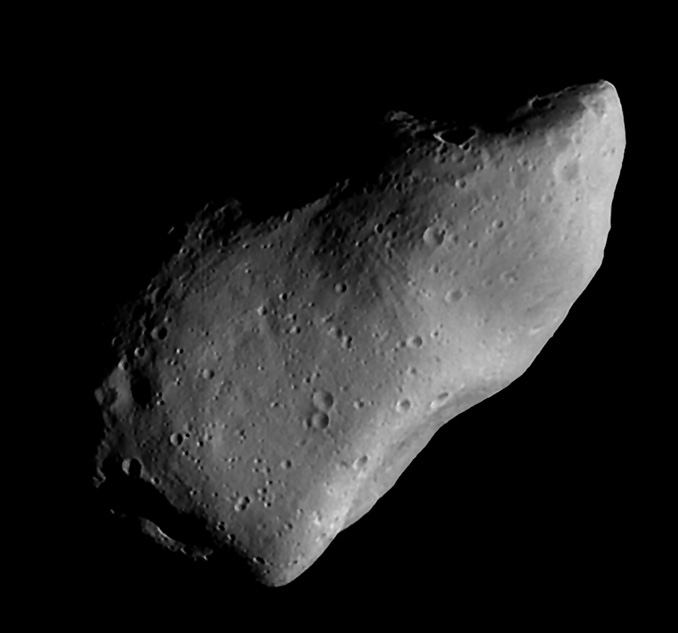
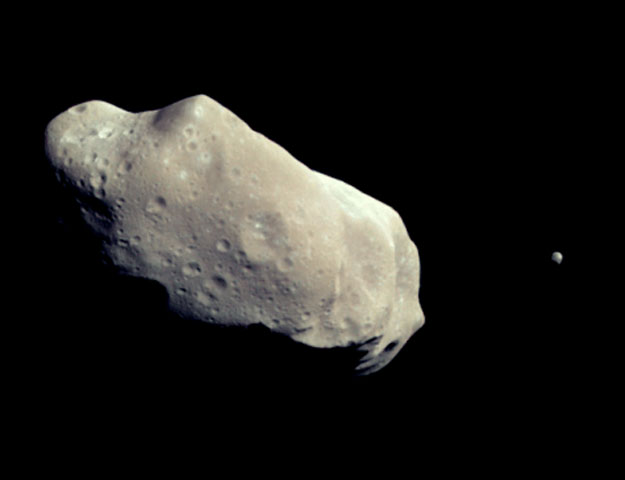 The main-belt asteroids encountered by Galileo while en route to Jupiter. Left: (951) Gaspra on October 29, 1991. Right: (243) Ida on August 28, 1993. The small moon Dactyl is at right. Both images courtesy NASA.
The main-belt asteroids encountered by Galileo while en route to Jupiter. Left: (951) Gaspra on October 29, 1991. Right: (243) Ida on August 28, 1993. The small moon Dactyl is at right. Both images courtesy NASA.
The incorporation of a “faster, better, cheaper” policy for spacecraft missions by NASA’s management during the mid-1990s allowed for the development of several smaller low-cost missions during subsequent years, quite a few of these being to the solar system’s “small bodies.” One of the earlier missions was the Near-Earth Asteroid Rendezvous (NEAR) mission, later renamed NEAR Shoemaker in honor of planetary geologist Eugene Shoemaker, which was launched on February 17, 1996. NEAR Shoemaker’s primary destination was the large near-Earth asteroid (433) Eros, but while en route to Eros NEAR Shoemaker passed by the main-belt asteroid (253) Mathilde on June 27, 1997. NEAR Shomaker arrived at Eros in late 1998 but an aborted engine burn prevented an insertion into orbit, so that event had to wait until the next encounter with Eros which took place on February 14, 2000. NEAR Shoemaker then spent the next year in orbit around Eros before performing a soft-landing onto Eros’ surface on February 12, 2001. The NEAR Shoemaker mission, and some of its findings, are discussed in the Week 4 “Special Topics” presentation on Eros.
NASA’s Deep Space 1 mission was intended as a technology test bed, including the testing of an ion propulsion engine. Following its launch on October 24, 1998, Deep Space 1 passed just 26 km from the Mars-crossing asteroid (9969) Braille on July 29, 1999, however problems with the tracking system and some of the onboard instruments allowed images to be obtained from only a farther distance. Deep Space 1 then went on to a successful encounter with Comet 19P/Borrelly on September 22, 2001, with images revealing the nucleus to be a bowling pin-shaped object roughly 8 km by 4 km across.
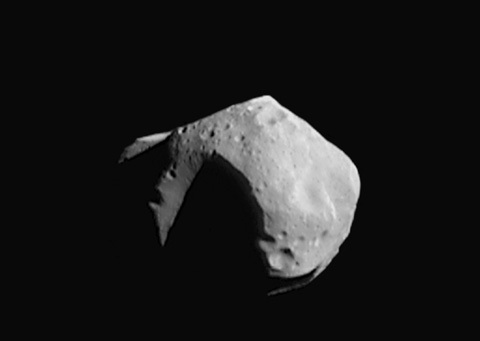
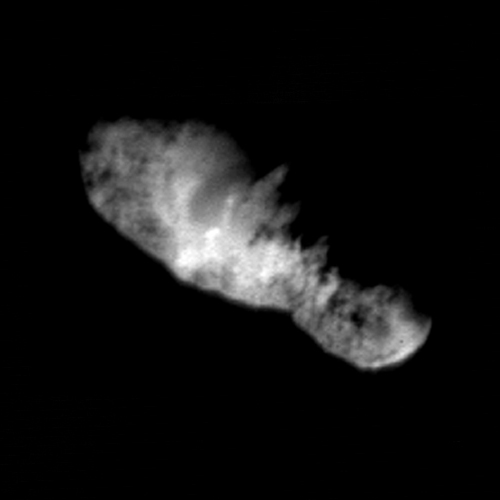 LEFT: Main-belt asteroid (253) Mathilde, as imaged by the Near-Earth Asteroid Rendezvous (NEAR) Shoemaker spacecraft on June 27, 1997. Courtesy NASA. RIGHT: The nucleus of Comet 19P/Borrelly, as imaged by NASA’s Deep Space 1 spacecraft on September 22, 2001. Courtesy NASA.
LEFT: Main-belt asteroid (253) Mathilde, as imaged by the Near-Earth Asteroid Rendezvous (NEAR) Shoemaker spacecraft on June 27, 1997. Courtesy NASA. RIGHT: The nucleus of Comet 19P/Borrelly, as imaged by NASA’s Deep Space 1 spacecraft on September 22, 2001. Courtesy NASA.
NASA’s Stardust mission was launched on February 7, 1999, and while passing through the asteroid belt passed 3000 km from the main-belt asteroid (5335) Annefrank on November 2, 2002. Stardust’s primary destination was Comet 81P/Wild 2, which it encountered on January 2, 2004, and via means of a very lightweight, porous substance called “aerogel” collected material samples from that comet’s coma which it returned to Earth two years later; this is discussed in more detail in Comet Wild 2’s Week 1 “Comet of the Week” presentation. Meanwhile, as discussed in this week’s “Comet of the Week” presentation, Stardust later went on to an encounter with Comet 9P/Tempel 1 on February 15, 2011 and successfully recorded images of the impact crater that the projectile from the Deep Impact mission created in 2005. Stardust was shut down after its encounter with Comet Tempel 1.

for an encounter with the Apollo-type asteroid (163249) 2002 GT in January 2020, however communications with EPOXI broke off in 2013 and the mission was subsequently declared lost.
JAXA’s Hayabusa mission was an ambitious mission that was designed to travel to the Apollo-type asteroid (25143) Itokawa, perform detailed studies of it, and collect samples for return to Earth. Following its launch on May 9, 2003, Hayabusa arrived at Itokawa on September 12, 2005 but thereafter the mission was beset by several difficulties: a planned surface rover, MINERVA, failed, and the brief touchdown/sample collection effort on November 25 also apparently failed. After Hayabusa left Itokawa in December contact was lost, although contact was eventually restored several months later; several more months elapsed before power could be fully restored. This forced a three-year delay in Hayabusa’s planned return to Earth, but this finally happened on June 13, 2010. Once the sample-containing capsule was recovered from its touchdown site in the Australian outback researchers found that approximately 1500 grains (with a total mass slightly less than one gram) had in fact been collected during Hayabusa’s brief touchdown on Itokawa’s surface.
As its mission name implies, the rationale for NASA’s Dawn mission was to examine conditions that existed during the era of the solar system’s formation. Following its launch on September 27, 2007 Dawn arrived at the large main-belt asteroid (4) Vesta on July 16, 2011. Dawn remained in orbit around Vesta for the next 13½ months before leaving on September 5, 2012, en route to the largest main-belt asteroid (and “dwarf planet”) (1) Ceres, where it arrived on March 6, 2015 – becoming the first spacecraft to orbit around two different bodies. Dawn has remained in orbit around Ceres ever since, although after running out of maneuvering fuel the mission was declared ended on October 30, 2018, and contact was broken off. Some of the results from Dawn are discussed in the Week 1 “Special Topics” presentation.
The China National Space Administration (CNSA) launched its Chang’e 2 spacecraft on October 1, 2010, with its primary mission being a study of the moon from lunar orbit in preparation for the Chang’e 3 mission which landed on the lunar surface in December 2013. Following the completion of its original mission Chang’e 2 was moved to the sun-Earth L2 Lagrangian point 1.5 million km directly anti-sunward of Earth, however in April 2012 it was moved from L2 for an encounter with the Apollo-type asteroid (4179) Toutatis, which it passed by at a distance of just 3.2 km on December 13 of that year.
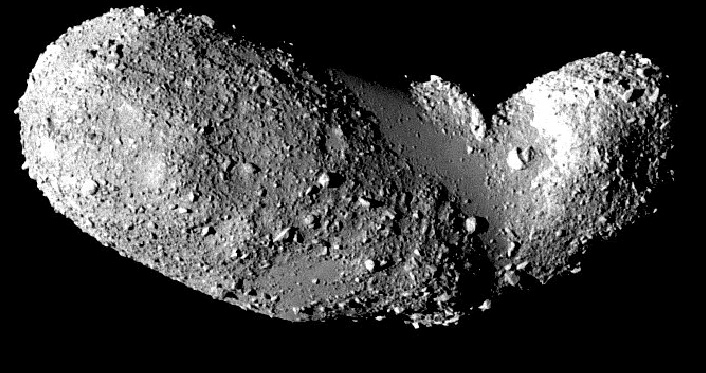
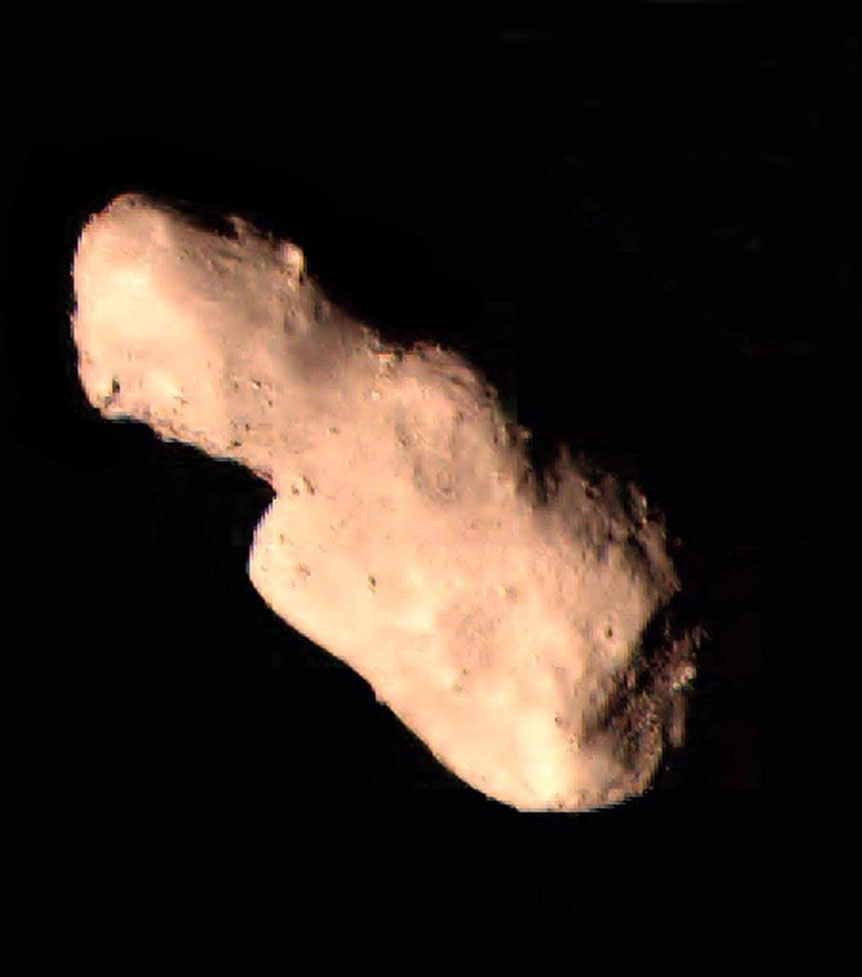 Two near-Earth asteroids imaged by visiting spacecraft. Left: (25143) Itokawa, imaged by JAXA’s Hayabusa spacecraft during its approach in 2005. Courtesy JAXA. Right: (4179) Toutatis, imaged by the Chang’e 2 spacecraft on December 13, 2012. Courtesy CNSA.
Two near-Earth asteroids imaged by visiting spacecraft. Left: (25143) Itokawa, imaged by JAXA’s Hayabusa spacecraft during its approach in 2005. Courtesy JAXA. Right: (4179) Toutatis, imaged by the Chang’e 2 spacecraft on December 13, 2012. Courtesy CNSA.
One of the most ambitious spacecraft missions was ESA’s Rosetta mission, which was launched from Kourou, French Guiana on March 2, 2004. The early phases of Rosetta’s mission involved several gravity-assist flybys of Earth and Mars, and encounters with the small main-belt asteroid (2867) Steins on September 5, 2008 and the larger main-belt asteroid (21) Lutetia on July 10, 2010. After its encounter with Lutetia Rosetta was placed in a state of hibernation, from which it was “woken” in January 2014. On August 6 of that year Rosetta arrived at Comet 67P/Churyumov-Gerasimenko, which it would spend the next two years orbiting and studying as the comet approached perihelion (in August 2015) and then receded. While in the comet’s vicinity Rosetta deployed the Philae lander in November 2014, and after the mission was completed Rosetta successfully touched down on the comet’s surface on September 30, 2016. Comet 67P is a future “Comet of the Week” and the Rosetta mission is discussed in more detail in that object’s presentation.
Two “small bodies” spacecraft missions are ongoing at this time, both of these being sample-collection missions involving near-Earth asteroids: JAXA’s Hayabusa2 mission to (162173) Ryugu and NASA’s OSIRIS-REx mission to (101955) Bennu. Hayabusa2 has now left Ryugu and on its way back to Earth and is scheduled to arrive this coming December, while OSIRIS-REx, which has been in orbit around Bennu since late 2018, is scheduled to collect its samples later this year, and will depart Bennu in March 2021 for arrival at Earth in September 2023. These two missions are discussed in a future “Special Topics” presentation.
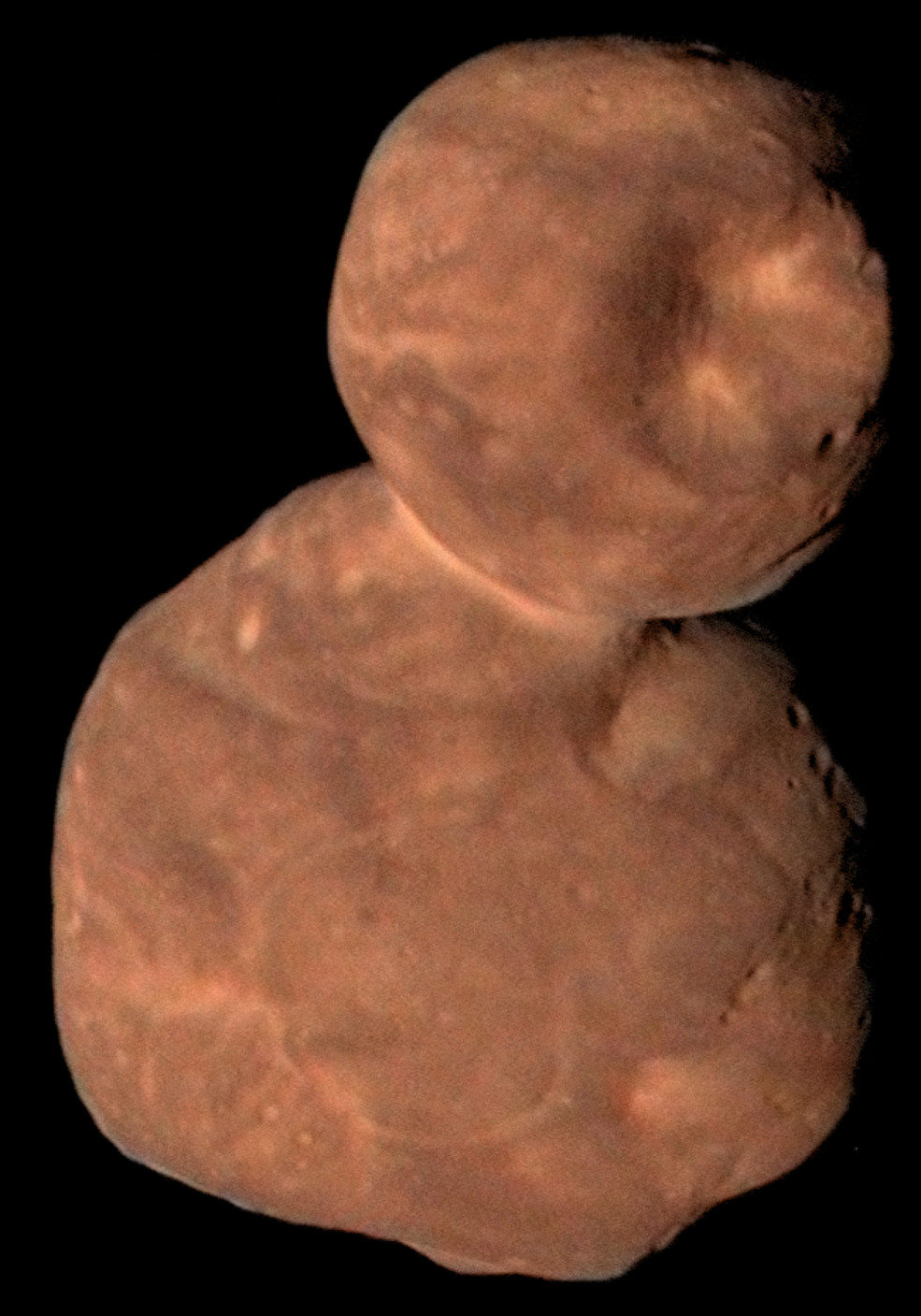
The missions described here are certainly not the last word in spacecraft missions to small bodies; various other missions are being planned and are in development at this time. These are all discussed in a previous “Special Topics” presentation.
“Special Topics” archive
Ice and Stone 2020 home page
Earthrise Institute home page